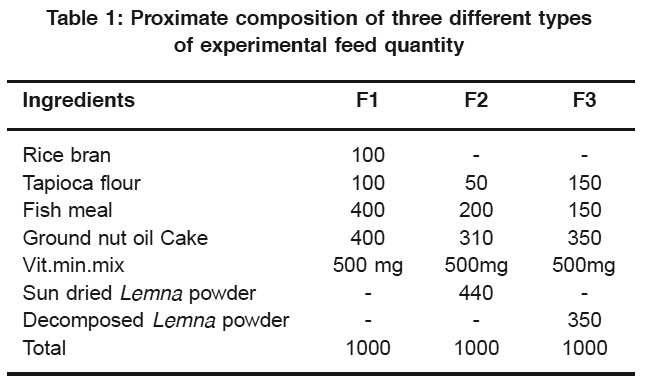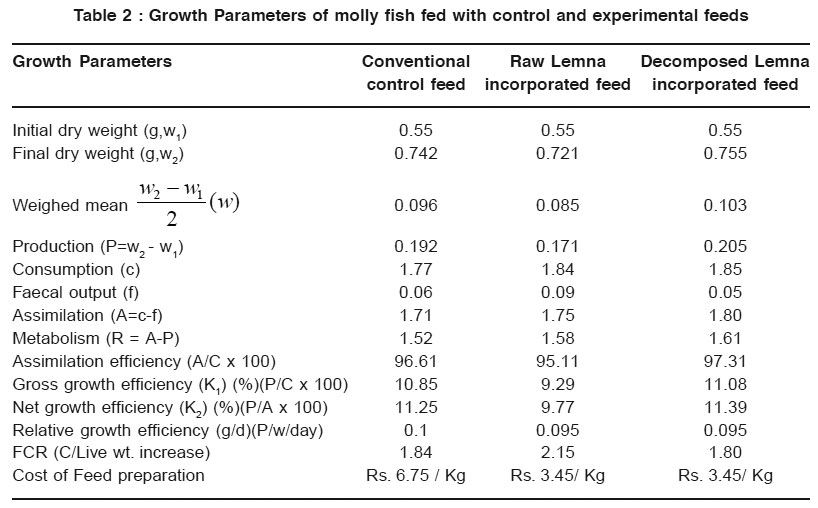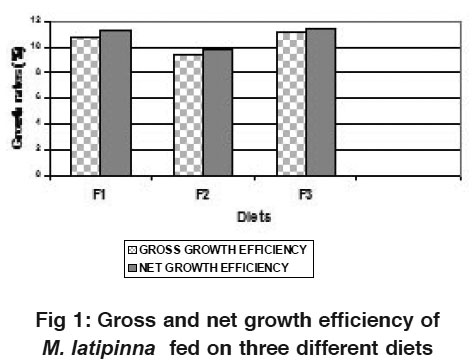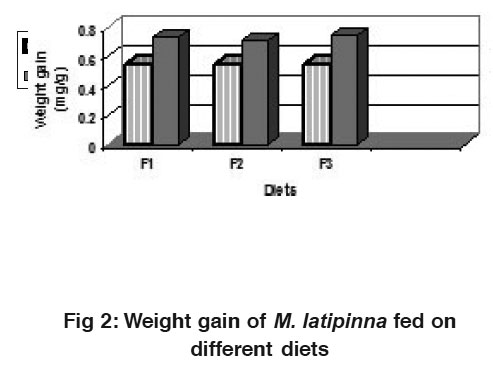Effect of sewage cultured Lemna minor on growth of Mollinesia latipinna fed on mixed diets
D. Radhika1 , C. Veerabahu1 and M. Marippandi1 *
DOI: http://dx.doi.org/10.12944/CWE.4.2.21
Effect of sewage cultured Lemna minor on growth of Mollinesia latipinna was investigated using three different types of feeds viz.control feed (F1), raw lemna incorporated feed (F2) ,and decomposed lemna incorporated feed (F3) for 20 days. The feeds were prepared by using sewage cultured L.minor .The test animals fed with decomposed lemna incorporated feed showed high production (0.205) ,Gross growth efficiency (11.08 %), Net growth efficiency (11.39 %) ,Assimilation efficiency (97.31)and Metabolism (1.61). Raw L.minor incorporated fish feed showed slightly low value of Metabolism (1.58), Assimilation (1.75) and relative growth efficiency.
Copy the following to cite this article:
Radhika D, Veerabahu C, Marippandi M. Effect of sewage cultured Lemna minor on growth of Mollinesia latipinna fed on mixed diets. Curr World Environ 2009;4(2):399-403 DOI:http://dx.doi.org/10.12944/CWE.4.2.21
Copy the following to cite this URL:
Radhika D, Veerabahu C, Marippandi M. Effect of sewage cultured Lemna minor on growth of Mollinesia latipinna fed on mixed diets. Curr World Environ 2009;4(2):399-403. Available from: http://www.cwejournal.org/?p=996
Download article (pdf) Citation Manager Publish History
Select type of program for download
| Endnote EndNote format (Mac & Win) | |
| Reference Manager Ris format (Win only) | |
| Procite Ris format (Win only) | |
| Medlars Format | |
| RefWorks Format RefWorks format (Mac & Win) | |
| BibTex Format BibTex format (Mac & Win) |
Article Publishing History
| Received: | 2009-05-20 |
|---|---|
| Accepted: | 2009-07-01 |
Introduction
Fish, orange molly M. latipinna is one of the most attractive and economically important among the aquarium fishes . They are marketed all over the world and yield foreign exchange to some extent. Formation of a suitable feed for fishes has become important for potential aquaculture practice and many authors have studied the effects of nutrition on growth of fishes (Mathavan 1976, Degani et al.,1985; Wahlam & Shephared 1988; Khan and Jafri 1994; Kim et al., 1996.) but less attention has been paid to or namental fishes (Degani and Gur,1992; Lochmann and Philips 1994; James and Sampath 1998).
Sewage grown micro algae Chlorella vulgaris utilization as a component of compounded fish feed for many cultivable aquatic organisms has been well documented (Becker 1978). Meske and Pfeffer (1977) have been reported that unicellular algae can replace 30- 80 % of commercial fish meal in the fish feed preparation. Edward (1980 ) stated that there are number of herbivorous fishes which directly consume aquatic weeds. Aquatic macrophytes have been known to have potential value as human food , live stock fodder, fertilizers and food for herbivorous fishes ( Edward, 1980 ). The growth performance, food conversion ratio and protein efficiency ratio along with nutritional qualities of weeds that are incorporated in pelleted feeds in fish have been reported by Tan (1970), Hajra and Tripathi (1985), Hajra (1987), Patra and Ray (1988) and Das et al., (1989).
Materials and Methods
The sewage sample was collected in three plastic cans ( 35 lit ) from Buckle channel ,KVK Nagar, Tuticorin Town (Tamil Nadu ,India ). After bringing to the laboratory , sample was filtered through a clean cotton cloth and kept in circular plastic trough . Nutrient analysis was done after the sample was filtered with the help of laboratory filter paper. Raw sewage was aerated in order to elevate the oxygen content and reduce the organic load .
Fresh L. minor plants were collected and counted before introducing them in to the trough on 16 th day of experiment .This served as the experimental trough and the trough without plant acted as control one. The nutr ients removal efficiency was calculated. At the climax of the experiment plants were counted and biomass also calculated .This plants were allowed to decompose in the laboratory condition and protein content was estimated regularly, at the time of elevation of protein content the plant was taken out and dried in hot air oven.
Fish feed were prepared by using this decomposed L.minor (F2) as one of the ingredients and raw L.minor (F3) was also used .The pelleted diet containing 40% protein was maintained throughout the experimental period ,and was prepared adopting the box model of Ali (1982). Feed trials were conducted with molly fish by feeding them with three types of feeds F1 (conventional control feed ), F2 and F3 .
The selected juveniles of M.lattipinna were divided in to three groups and kept in three plastic troughs.Water quality parameters were also maintained.The weighing of fish during and on termination of the experiment was as described by Hasan et al., (1989).
Results
In the present investigation, three different types of feeds viz. conventional control feed (F1), and raw Lemna sp.(F2) and decomposed Lemna sp. Incorporated (F2) feeds were used to grow the test animal, molly for the analysis of various growth parameters. From the results of the feed trial experiments conducted, it became conspicuous that minimum energy loss for maintenance and metabolism occurred in test animals fed with experimental diets coupled with high assimilation efficiency (97.31). Gross (11.08) and Net (11.39) growth efficiencies were also appreciably high in experimental feeds than in the control feed.
 |
Table 1: Proximate composition of three different types of experimental feed quantity Click here to view table |
Students 't' test analysis, conducted on different growth parameters of the test animals fed with three different diets showed the following results. In the case of production there was significant variation between the three feeds. But there was no significant recorded between the three feeds in the case of metabolism. Assimilation efficiency significantly varied among the three feeds (P<0.001, P< 0.005, P<0.001) .Gross growth efficiency and food convertion ratio recorded in the three test feeds were also significant (P<0.02, P<0.05, P<0.01) .
The proximate composition of L. minor recorded in the present study was highly comparable to the previous reports of Hyde et al., (1984) and Manimaran et al., 1997. As registered in the present study L. minor has been recorded to double in number with in 4 days as reported by Manimaran et al., (1997). The collected L. minor was allowed to decompose in quality water for two weeks. Following the decomposition the protein content of Lemma minor was observed to obtained the highest value of 47.2%.
 |
Table 2 : Growth Parameters of molly fish fed with control and experimental feeds Click here to view table |
 |
Figure 1: Gross and net growth efficiency of M. latipinna fed on three different diets Click here to view figure |
 |
Figure 2: Weight gain of M. latipinna fed on different diets Click here to view figure |
Discussion
Raw sewage sludge contain 36% protein Manimaran et al ., (1995 ). In the experimental plant L.minor gets the protein content was notably increased (10.4 mg/g). It may be due to nutrient absorption from the sewage which gets converted into plant nitrogen. Though 40% protein content was maintained in all the three types of feed , experiment conducted showed high va r iation in growth parameters. The highest production value ( 0.205 ) was registered when the test animal was fed with experimental feed (F3). When raw L. minor was used as a component of fish feed the recorded production (0.171g) was less than that on the control feed ( 0.192 g). The growth performance ,FCR and protein efficiency ratio along with nutritional qualities of weeds that were incorporated in polluted feeds in fish had been reported by Tan (1970), Hajra and Tripathi (1985), Hajra (1987), Patra and Ray (1988) and Das and Ray (1989).
Feed trials conducted with (F3) showed highest assimilation efficiency ,gross and net growth efficiency coupled with nutrient content of L.minor, Skilicorn et al., (1983 ) reported that essential amino acids like methionine and lysine that occurred in Lemna. sp, were not encountered in other terrestrial plants.Thus it could be possible to conclude that if complex carbohydrates, lignin and cellulose like components are broken in to simple sugars and also high level of carotene contents (Skilicorn et al.,1993), increased level of crude protein (Hyde et al., 1984). Since the total carotene content of duck weed meal is known to contain higher concentration (10 folds) carotene than other terrestrial plants (Skillicorn et al., 1993). There are 40 different species of duck weed belonging to 4 genus (Lemma, Spinodela, Wolfia and Wolffiella) are known to occuring in India. Similar feed trial experiments need to be conducted with other species of duck weeds in fresh and decomposed condition to identify the right type of duck weed species which can not only Bio process waste water but also can convert the waste nitrogen efficiently into the production of ornamental fishes whith much market value both in India and foreign countries.
References
- Ali S A: Feed for mulation methods. In :Manual of research method for Fish and shellfish nutrition. CMFRI Publication, Cochin P. (1982) 95-99.
- Degani G, Horovitz A and Levanon D. Effects of protein level on impur ities ,diets,density,ammonia and o2 level on growth of Europian eel Anguilla anguilla (L). Aquaculture (1985) 46: 193-200.
- Degani G and Gur N: Growth of juvenile Trichogaster leerii on diets with various protein level. Aqua cult.Fish.Manag (1992) 23: 161-166.
- Das, Isita and Ray, A.K., Growth performance of the Indian Major Carp, Labeo rohita (Ham.) on duckweed (Lemna polyrhiza lin) incorporated pelleted feed : a preliminary study. J. Inland. Fish.Soc.India,(1989) 21(1): 19.
- Edward, P. Food potential of aquatic macrophytes. ICLARM. Studies and reviews. ICLARM, Manila (1980) 5:(51) pp.
- Hajra, A. and S.D. Tripathi. Nutritive value of aquatic weed, (Spirodela polyrhiza Linn. ) in grass Carp. Indian. J. Anim. Sci.,(1985) 55(8): 702-705.
- Hajra, A. Biochemical investigations on the protein-calorie availability in grass carp (Ctenopharyngodon idella val.) from an aquatic weed (Ceratophyllum demersum Linn. ) in the tropics. Aquacuture,(1987) 61: 113-120.
- Hyde, H.C., Ross, R.S. and Sturner, L., Technology assessment of aquaculture systems for municipal wastewater treatment. Environmental protection Agency, Municipal Engineering Research Agency, Municipal Engineer ing Researc Laborator y, Cincinnati, Ohio (1984).
- Hasan M R,Alam M G and Islam M A. Evolution of some indigenous ingredients as dietar y protein sources for the cat fish (Clarious batrachus ) fry ,In:Aquaculture research in Asia: Management techniques and nutrition . Eds:Huisman E A Zonneveld N and Boumans A H M.Pudoc.Press Wegeningen p. (1989) 125-137.
- James R and Sampath K: Effects of feed and water quality (hardness ) on growth in red sword tail Xippophorus helleri fry. Indian J. Fish.(1998) 45: 307-313.
- Khan M A and Jafri A K: Replacement of fish meal with soyabean meal in diets formulated for finger ling carp labeo rohita (Hamilton ).The third asian fisheries forum. P.663-666.Manila, Philipines (1994).
- Kim J Masses K C and Hardy R W: Adult Artemia as food for first feeding coho salmon (Onchorhyncjus kisutch). Aquaculture (1996) 144: 217-285.
- Lochmann R J and Phillips. Dietary protein requirement of juvenile golden shiners (Notemigonus crysoleucas) and gold fish (Carassius auratus) in aquaria. Aquaculture.(1994) 128: 277-285.
- Manimaran B ,Santhanam R and Ramadhas V. Treatment and utilization of coastal sewage sludge for aquaculture. P.93-95. In shrimp feeds. Eds: Jayaramasn R Santhanam R, U Sundararaj. K Venkata Ramanujam and G Sanjeeva raj. Proceedings of the seminar on Shrimp feeds and workshop on impact of coastal aquaculture on Environment. Tanuvas Publication No.BM 01/95.Tuticorin, India (1995).
- Manimaran, B., Ramadhas, V. & Santhanam, R., Cutivation of duckweed Lemna minor utilizing waste nutrients. In : R.Santhanam, V.Ramadhas and P.Gopalakr ishnan (Editors), Proceedings of the National Seminor on water quality issues in aquaculture systems. (1997)pp. 65-72.
- Meske, C.H. and Pfeffer, E., Tests on micro- algae, yeast and casein as components of afish meal free dry food for carp. Anim. Res. Dev. (1977) 7: 112-121.
- Patra, B.C. and A.K. Ray. A preliminary study on the utilization of the aquatic weed Hydrilla verticillat (L.F.) Royle as feed by the carp, Labeo rohita : growth and certain biochemical composition of flesh. Indian Biologist.1988 (b) 20(1): 44-50.
- Skillicorn, P., Spira, W., and Journey, W., Duck weed Aquaulture. A Wo r ld Bank Publication,(1993) P.76.
- Tan, Y.T. Composition and nutritive value of some grasses, plants and aquatic weeds tested as diets. J. Fish. Biol.,(1970) 2: 253-267.
- Wah Lam S and Shepherd K L: Some effects of natural food levels and high protein supplement o0n the gr owth of car p. Aquaculture (1988) 72: 131-138.







